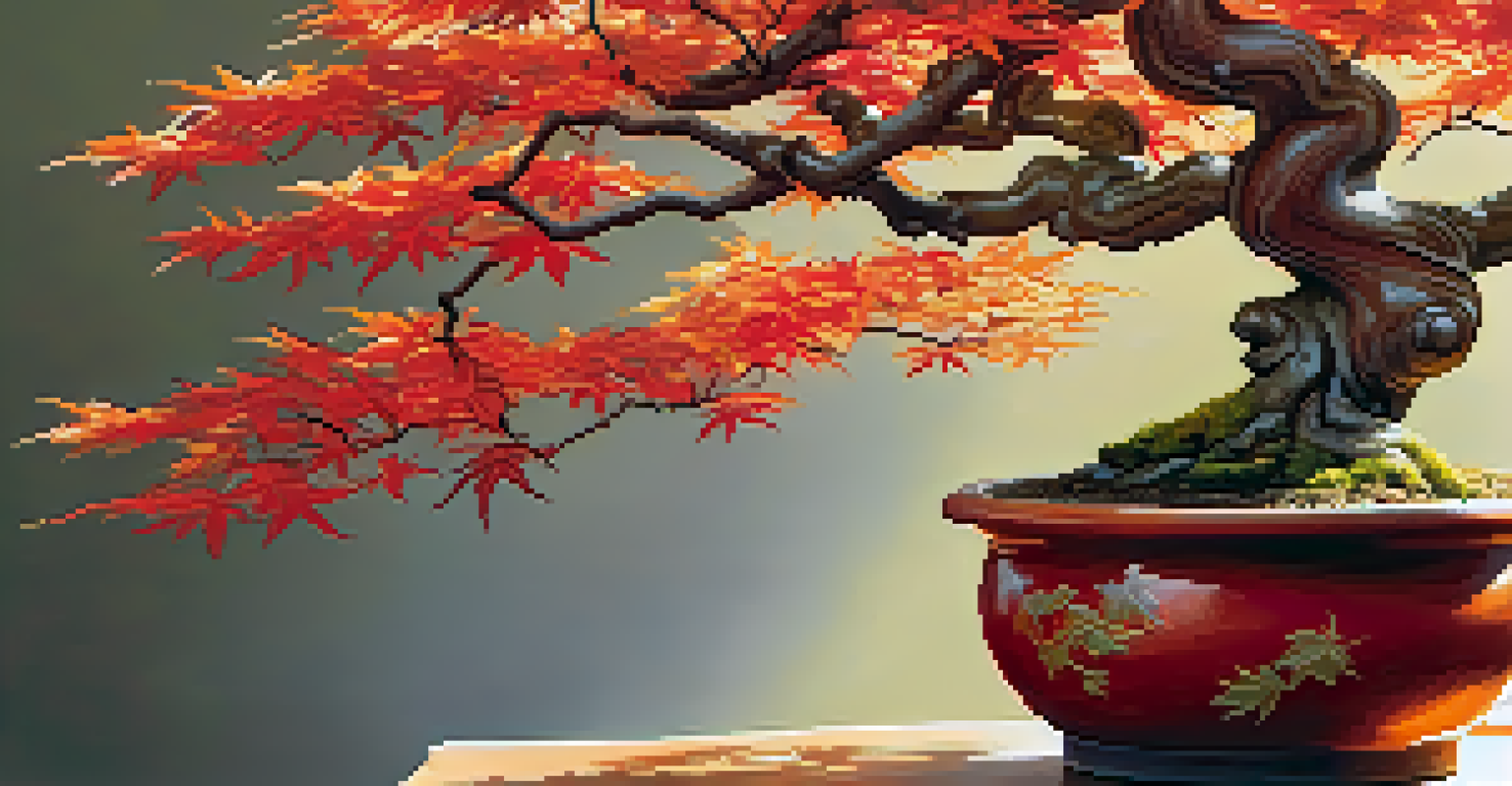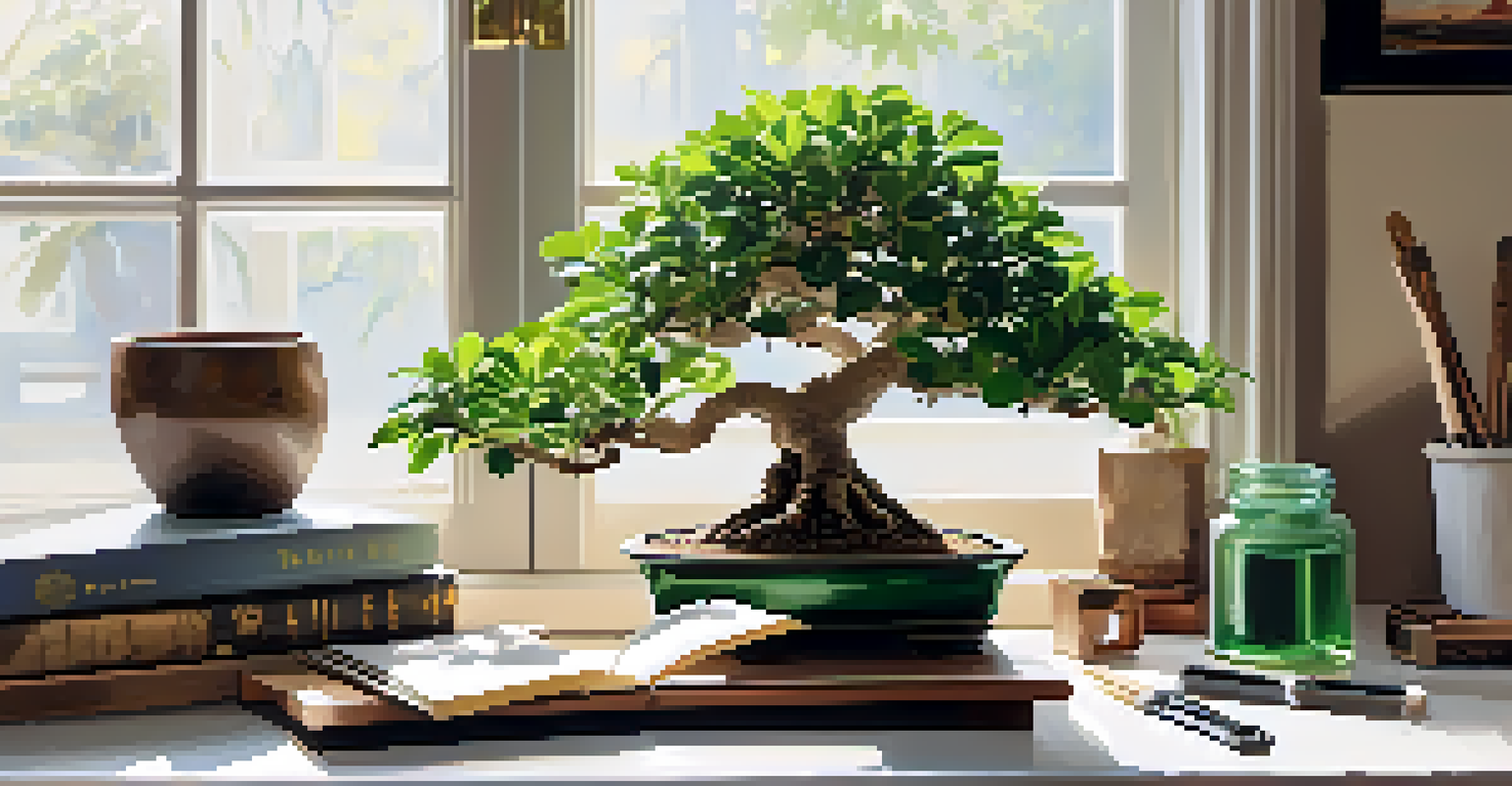Choosing the Right Tree Species for Your Bonsai Project

Understanding the Basics of Bonsai Trees
Bonsai is more than just a way to grow a tree; it's an art form that requires careful selection of the right species. Each tree species brings its unique characteristics, which can affect the overall look and maintenance of your bonsai. Understanding these basics is crucial for anyone looking to cultivate a bonsai that not only survives but thrives.
The creation of a bonsai is not just about the tree; it's about the relationship between the artist and the plant.
When starting your bonsai journey, consider factors such as growth patterns, leaf size, and seasonal changes. Some species may flourish indoors, while others are better suited for outdoor environments. Knowing these distinctions can help you make an informed choice that aligns with your care capabilities and aesthetic goals.
For example, the Ficus is often recommended for beginners due to its resilience and adaptability. It’s forgiving of mistakes and can thrive in various conditions, making it an excellent choice for those just starting out with bonsai.
Climate Considerations for Bonsai Species
One of the most important factors in selecting a bonsai tree species is the climate in which you live. Different trees thrive in different environments, so understanding your local climate is crucial. For instance, tropical species like the Jade Plant do exceptionally well in warm, humid conditions.

Conversely, if you live in a region that experiences cold winters, you might want to consider species such as the Japanese Maple, which can handle cooler temperatures. Each tree has distinct temperature and humidity preferences that will influence its growth and health.
Choose Bonsai Based on Climate
Selecting a bonsai species suited to your local climate is essential for ensuring its health and growth.
By choosing a species that is well-suited to your climate, you can significantly improve the chances of your bonsai flourishing. It reduces the stress on the tree, allowing it to grow more naturally and beautifully.
Assessing Your Skill Level with Bonsai Trees
Your experience level plays a significant role in determining which tree species to choose for your bonsai project. Beginners may want to start with species that are easy to care for, while seasoned enthusiasts might seek out more challenging varieties. This self-assessment can guide your selection process effectively.
The essence of bonsai is to create a miniaturized representation of nature, capturing the beauty and elegance of trees in a small form.
For example, tree species like the Chinese Elm or the Ficus are often recommended for beginners due to their hardiness and forgiving nature. On the other hand, advanced practitioners may find joy in cultivating species like the Pine, which require more precise techniques and care.
Understanding your skill level not only helps in the selection of the species but also sets realistic expectations for your bonsai journey. This alignment can enhance your overall experience and satisfaction.
Aesthetic Preferences in Bonsai Selection
When choosing a bonsai tree, your personal aesthetic preferences should not be overlooked. Different species have unique shapes, leaf structures, and seasonal changes that can significantly influence the overall appearance of your bonsai. Reflecting on what appeals to you visually can guide your choice.
For instance, if you adore the vibrant colors of autumn, consider trees like the Japanese Maple, which offers stunning fall foliage. Alternatively, if you prefer evergreen aesthetics, species like Juniper or Pine might be more suitable.
Assess Skill Level for Tree Choice
Understanding your experience with bonsai helps you select a species that matches your care capabilities.
Ultimately, selecting a species that resonates with your personal taste can transform your bonsai into a meaningful piece of art that you cherish for years to come.
Growth Rate and Maintenance of Bonsai Species
Different bonsai species come with varying growth rates, which can influence how much time and effort you'll need to invest in maintenance. Some trees grow quickly and require frequent pruning, while others have a slower pace, allowing for more manageable care routines. Understanding these differences can help you choose a species that fits your lifestyle.
For instance, the Serissa tree is known for its rapid growth, which means it will need more frequent trimming to maintain its form. In contrast, the Shimpaku Juniper grows slower, making it an excellent candidate for those who prefer less hands-on maintenance.
By considering how much time you’re willing to dedicate to your bonsai, you can select a species that aligns with your availability and desire for involvement in the growth process.
Pests and Disease Resistance in Bonsai Trees
Like any plant, bonsai trees are susceptible to pests and diseases, and some species are more resistant than others. When choosing a species, consider its vulnerability to common pests such as aphids or spider mites. Selecting a hardier species can save you a lot of trouble down the line.
For example, the Ficus tree is generally resilient against many pests, making it a popular choice among bonsai enthusiasts. In contrast, species like the Azalea may require more careful monitoring and treatment to ensure they remain healthy.
Consider Aesthetics in Selection
Your personal aesthetic preferences should guide your bonsai choice to create a meaningful piece of art.
By being mindful of potential pest issues, you can choose a species that not only suits your aesthetic and care preferences but also stands a better chance of thriving in your environment.
Resources for Researching Bonsai Tree Species
Once you've considered the various factors in choosing a bonsai species, the next step is to gather information. There are numerous resources available, including books, online forums, and local bonsai clubs, which can provide valuable insights and firsthand experiences. Engaging with these communities can enhance your understanding of different species.
For example, websites dedicated to bonsai gardening often include care guides and species comparisons, helping you make a more informed decision. Additionally, visiting local nurseries can give you the chance to see different species up close and ask experts for their recommendations.

Utilizing these resources will not only enrich your knowledge but can also connect you with fellow enthusiasts who share your passion for bonsai. This community engagement can make your bonsai journey even more rewarding.